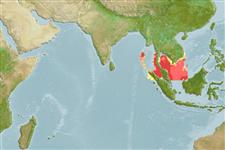Environment: milieu / climate zone / depth range / distribution range
Ecology
Marine; demersal. Tropical; 13°N - 2°N, 92°E - 111°E (Ref. 114953)
Eastern Indian Ocean and North-West Pacific; Thailand to Vietnam, including Malaysia.
Length at first maturity / Size / Weight / Age
Maturity: Lm 11.5, range 11 - 12 cm
Max length : 46.0 cm TL male/unsexed; (Ref. 9913)
Found in continental waters, both inshore and offshore (Ref. 9913); primarily inshore on soft substrates (Ref. 114953). Probably feeds on small benthic invertebrates. Females reported to produce 4 pups a litter (Ref. 114953). Biology little known (Ref. 9913). Maturity size of males reaches at 8-10 cm TL (Ref. 114953).
Life cycle and mating behavior
Maturities | Reproduction | Spawnings | Egg(s) | Fecundities | Larvae
Compagno, L.J.V. and P.R. Last, 1999. Narkidae. Sleeper rays. p. 1443-1446. In K.E. Carpenter and V.H. Niem (eds.) FAO identification guide for fishery purposes. The living marine resources of the Western Central Pacific. FAO, Rome. (Ref. 9913)
IUCN Red List Status (Ref. 130435)
Human uses
Fisheries: commercial; aquarium: public aquariums
Tools
Special reports
Download XML
Internet sources
Estimates based on models
Preferred temperature (Ref.
123201): 23.2 - 28.4, mean 27.3 °C (based on 365 cells).
Phylogenetic diversity index (Ref.
82804): PD
50 = 1.0002 [Uniqueness, from 0.5 = low to 2.0 = high].
Bayesian length-weight: a=0.01000 (0.00244 - 0.04107), b=3.04 (2.81 - 3.27), in cm total length, based on all LWR estimates for this body shape (Ref.
93245).
Trophic level (Ref.
69278): 3.3 ±0.3 se; based on size and trophs of closest relatives
Resilience (Ref.
120179): Low, minimum population doubling time 4.5 - 14 years (Assuming fecundity<100).
Fishing Vulnerability (Ref.
59153): Moderate vulnerability (36 of 100).
